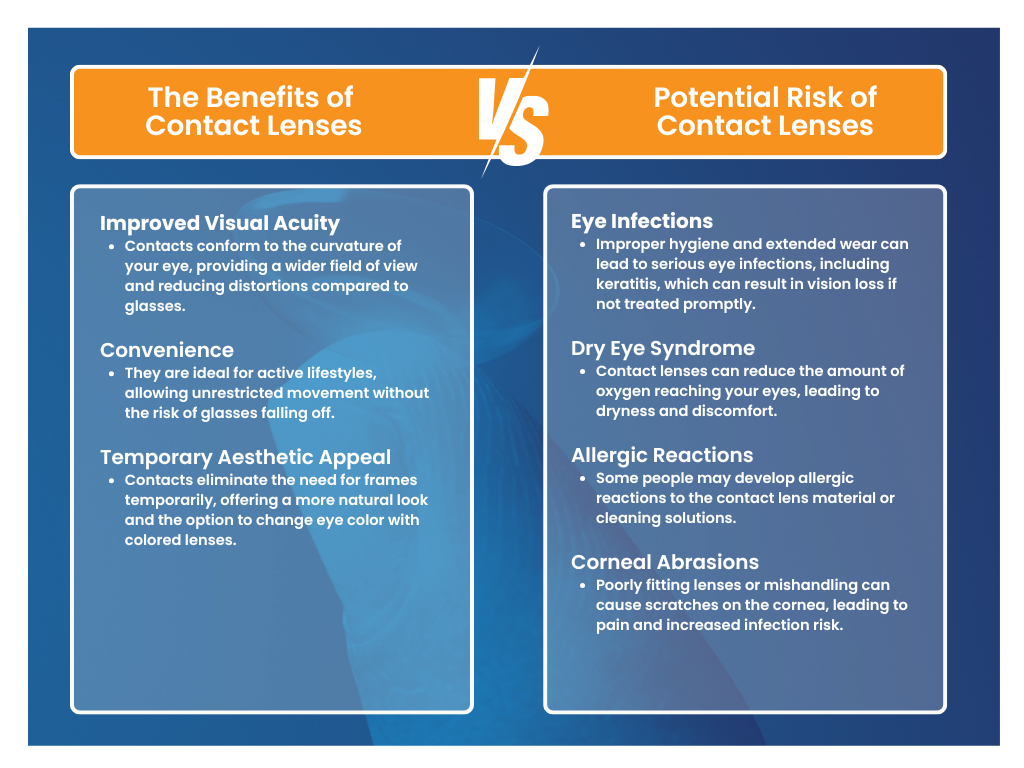Contact lenses are a widely used solution for vision correction, highly valued for their convenience and comfort. Yet, wearing contact lenses can come with risks, especially when they are not cared for properly. In this article, we will delve into the risks of contact lenses, common symptoms of related complications, and ways to minimize these risks.
Risks Associated with Contact Lens Use
While contact lenses are generally safe, improper use or care significantly increases the risk of serious eye conditions, including:
- Keratitis (Corneal Inflammation): A common infection often caused by germs invading the cornea.
- Dry Eyes: A common issue leading to discomfort and redness.
- Allergic Reactions: Irritation or sensitivity to lens materials or solutions.
- Giant Papillary Conjunctivitis: Bumps forming under the eyelid due to prolonged lens wear.
- Corneal Abrasion: Scratches on the cornea caused by mishandling lenses.
- Contact Lens-Induced Acute Red Eye (CLARE): A condition characterized by red, irritated eyes.
- Corneal Infiltrates: Inflammation or irritation indicative of infection.
- Neovascularization: New blood vessel growth on the cornea, sometimes resulting in redness.
- Conjunctivitis (“Pink Eye”): An infection causing redness and discharge.
According to the FDA, “Wearing contact lenses puts you at risk of several serious conditions, including eye infections and corneal ulcers.” Additionally, the CDC highlights the increased risk of keratitis associated with contact lens wear.
Reducing the Risks of Contact Lenses
Preventing irritation, infection, or discomfort requires proper hygiene and care. Here are some evidence-based recommendations from Harvard Medical School:
- Hand Hygiene: Always wash your hands with soap and water before handling contact lenses.
- Lens Cleaning: Use only the cleaning solutions recommended by your eye doctor. Never use saliva or water to clean lenses.
- Avoid Makeup Contamination: Insert lenses before applying makeup and remove them before makeup removal.
- Replace Your Lens Case: Clean and air-dry your case daily, and replace it every three months.
- Adhere to Wear Schedules: Follow the replacement schedule recommended for your lenses (daily, weekly, etc.).
- Avoid Sleeping in Lenses: Unless specifically approved by your eye doctor, do not sleep with your lenses in.
- Regular Checkups: Schedule an eye exam at least once a year to monitor eye health and lens
Recognizing Symptoms of Contact Lens Complications
Identifying potential eye infections early can help prevent serious complications. Watch for these warning signs:
- Blurry Vision: Sudden or persistent visual changes.
- Redness: Unusual or pronounced redness in the eye.
- Pain or Discomfort: Persistent pain that doesn’t improve with lens removal.
- Excessive Tearing or Discharge: Abnormal tearing or mucus-like discharge.
- Light Sensitivity: Heightened sensitivity to light.
- Foreign Body Sensation: A feeling of something in the eye even when nothing is present.
If you experience any of these symptoms, consult an eye care professional immediately to prevent further damage or potential vision loss.
Alternatives to Contact Lenses
If contact lenses are causing frequent issues, consider alternatives such as:
- Glasses: A simple, non-invasive option for vision correction.
- LASIK Eye Surgery: A popular and effective procedure to correct vision permanently. Schedule a FREE comprehensive eye exam at The LASIK Vision Institute, to assess your candidacy for LASIK. This 60-90 minute consultation includes a personalized evaluation of your eye health and vision needs.
Understanding the risks associated with contact lenses and practicing good hygiene, you can protect your eye health and enjoy the convenience they provide. If you’re considering alternatives or need expert guidance, consult your eye care professional today.

Find a LASIK Surgery Location Near You
We’re located nationwide – it’s easy to find a LASIK Vision Center near you.
References
What causes contact lens-related eye infections. (2024, April 15). Healthy Contact Lens Wear and Care. https://www.cdc.gov/contact-lenses/causes/index.html
Shmerling, R. H., MD. (2021, August 3). Can wearing contacts harm your vision? Harvard Health. https://www.health.harvard.edu/blog/can-wearing-contacts-harm-your-vision-202108032559
Contact lens risks. (2018, September 4). FDA. https://www.fda.gov/medical-devices/contact-lenses/contact-lens-risks




